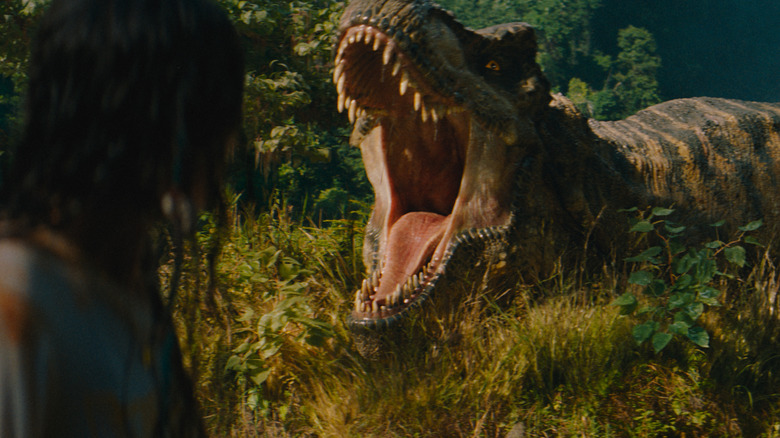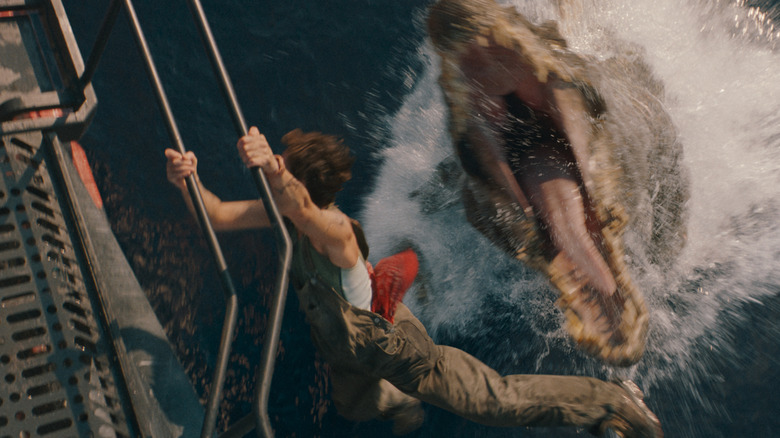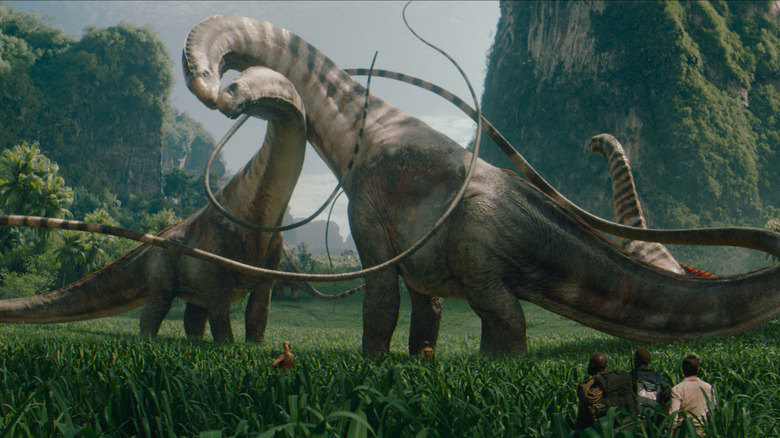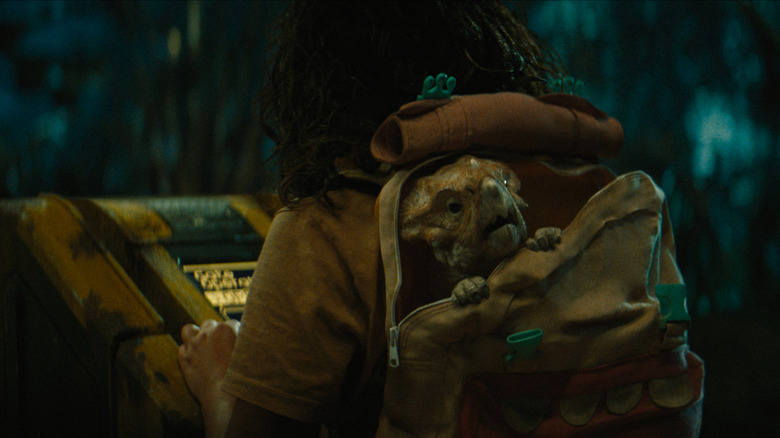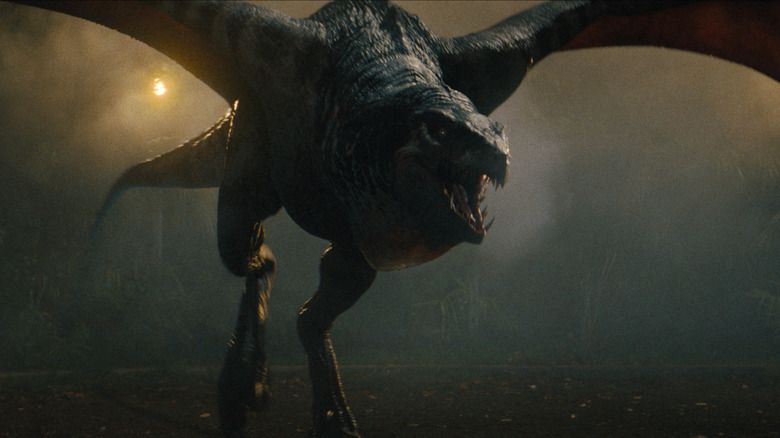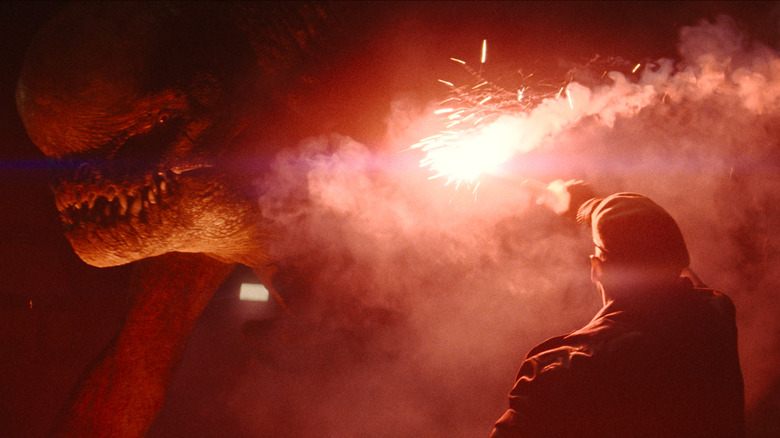The New Dinosaurs Of Jurassic World Rebirth Explained
Warning: Objects in mirror are more spoilery than they appear. This article discusses major plot details from "Jurassic World Rebirth."
Of all the blockbuster franchises that are essentially "critic-proof" these days, the "Jurassic World" movies would have to go right near the top of the list. /Film's review of "Jurassic World Rebirth" (written by yours truly) could generously be described as mixed negative, but here's the thing: It doesn't matter. The people have spoken, and the people clearly want dinosaurs on the big screen. Sadly, audiences neglected to bring that same energy to original movies like the Adam Driver-starring "65," so Hollywood at large is now convinced that everyone's childhood obsession can only work within the friendly confines of franchise filmmaking. Take a long look in the mirror and think about what you've done, folks.
Still, even the most ardent "Jurassic Park" purists would have to admit that the dino-mayhem on display in the "Jurassic World" movies are well worth the price of admission, and the same holds true in "Rebirth." And in the hands of director Gareth Edwards, the extinct reptiles (not lizards!) have rarely looked better. That includes fan-favorite throwbacks like the fearsome Tyrannosaurus rex, but also a bevy of new additions that we've never actually seen depicted on-screen before. An article about every single new dinosaur on display would probably take all day to read, so we've rounded up the most significant ones — and one familiar face that's undergone a startling makeover since the last time we saw it — for our breakdown here.
Naturally, this involves getting into spoiler territory, so read on only if you've already watched "Jurassic World Rebirth."
Spinosaurus (sort of)
Scientifically-accurate dinosaurs? In my "Jurassic World" movies??? The recent sequels won't exactly win over the hearts and minds of any paleontologists out there, but they have at least tried to make these movie monsters somewhat more reflective of their real-life counterparts. Naturally, that can't help but ruffle a few feathers out there. (Get it? Feathers? Because we now know several dinosaurs had feathers? Keep up with me, people.) But the biggest swing yet comes in the form of what "Rebirth" does to the Spinosaurus during one of the earliest set pieces in the film, when our hapless humans make the mistake of interfering with a Mosasaurus (which we've seen in "Jurassic World" before) on its own home turf.
This ain't your daddy's Spinosaurus, though. Fans will remember the lumbering, massive, and downright terrifying version of the dinosaur from "Jurassic Park III" — you know, the one that pooped out fully-functioning satellite phones, was given the preternatural ability to find our very specific human protagonists no matter where they were on the island, and had the gall to snap the neck of our beloved T-Rex like the villain it is. This time around, well, casual viewers would be forgiven for thinking that these Spinos in "Rebirth" are a completely different animal altogether. As it turns out, Gareth Edwards and his design team decided to tweak things significantly. These new versions are smaller, hunt in packs, and most notably seem right at home in aquatic environments. All of this reflects actual research and theories of how scientists believe Spinosaurus truly lived all those tens of millions of years ago, which any dinosaur nerd can appreciate.
Titanosaurus
One of my all-time favorite pastimes is smugly correcting every filthy casual who assumes that every long-necked dinosaur they see is either a Brachiosaurus or Brontosaurus. Believe it or not, there were many more types of sauropod species (the scientific term for these giant herbivores) than that. The original "Jurassic Park" brought the majestic Brachiosaurus to the front and center of our lexicon, but "Rebirth" features a very different — though distantly related — family member in the form of the towering Titanosaurus.
Described in the film as the largest dinosaur on Earth, the Titanosaurus plays a major role in "Rebirth." Our mercenary group, led by Scarlett Johansson's Zora Bennett, must recover DNA extracts from three of the biggest animals currently on Earth. The Titanosaurus is one of them and, ironically, the only actual dinosaur of the trio (as the Mosasaurus and Quetzalcoatlus belong to different groups of extinct mammals, completely unrelated to dinos). In real life, paleontologists have only ever discovered fragments of skeletons, which means a lot of guesswork has gone into how they actually looked and functioned. "Jurassic World Rebirth" takes plenty of creative liberty here, adding small but memorable sail features on their backs and even depicting two in the throes of lovemaking. (True Gareth Edwards fans, going back to his 2010 indie debut "Monsters" and the MUTOs in "Godzilla," know that he's been single-handedly trying to bring back monster-f***ing.)
The Titanosaurus also provides the most overt reference to the original "Jurassic Park," as composer Alexandre Desplat shows off his take on John Williams' classic theme to convey the awe and wonder of the biggest animals to ever walk the planet.
Aquilops
Dolores stans, rise up! The "Jurassic" movies have always kept kids at the forefront of these adventures, but "Rebirth" adds a whole new twist in the form of the cuddliest, most adorable little dino you've ever seen. Clearly hoping to take advantage of the Baby Groot and Baby Yoda phenomenon, the creative team decided to add their own version in the form of Dolores. She makes her introduction to the film when the Delgado family, shipwrecked and rescued by the mercenaries before ending up stranded on different parts of the island, stumbles across the tiny dino on their way to get help at a nearby facility. Naturally, the rambunctious preteen Isabella (Audrina Miranda) basically decides to adopt Dolores as her pet and take her with her wherever they go.
Although never actually stated in dialogue, this herbivore belongs to the species known as Aquilops. Far less famous than its cousin, the Triceratops, the Aquilops still has it beat in terms of cuteness. Most interestingly, it appears Dolores isn't even a baby — this is (more or less) the size of full-grown members of this species. Admittedly, this is yet another dinosaur with all sorts of gaps in the fossil record, so maybe hold off on cloning your own version as a kid-friendly pet. Ultimately, Dolores doesn't actually do much to affect the plot of the movie, but who are we to deny the merchandising potential at play here? Does this pretty much contradict the original movie's themes about marketing and capitalism run amok? Probably. Are we still looking forward to getting a Dolores plushie of our own? You bet.
The Mutadon
On the exact opposite end of the spectrum from Dolores is the Frankenstein's monsters known as Mutadons. An unholy mashup of Velociraptors and winged Pteranodons, this represents the weirdest possible extreme of bioengineers attempting to clone theme park attractions that would win over jaded mass audiences who apparently got tired of "normal" dinos. This continues a thread that began in the 2015 "Jurassic World," in which genetic splicing and mutant dinosaurs became the newest trend. In "Rebirth," the Mutadon makes its first appearance as part of a clever fake-out moment. Just as familiar-looking Velociraptors close in Xavier (David Iacono), one of the castaways trying to survive on the island, a Mutadon attacks and inadvertently "saves" him from becoming lunch.
The Mutadons later show up in force when the humans finally make it to an abandoned facility to await rescue. These creatures are nastier, more formidable, and truly monstrous compared to their more "natural" counterparts, but there's a good reason for that. Mutadons are basically the proof-of-concept experiments gone horribly wrong, abandoned and left behind once it became clear that they wouldn't be a good fit for the actual park. As writer David Koepp once told Empire:
"Those came from my strange mind. We saw in some of the previous 'Jurassic World' movies that their experiments made dinosaurs bigger, meaner, scarier, and it occurred to me and Steven [Spielberg] that those can't all have gone well."
The Distortus rex
I don't know if anyone ever really wondered what would happen if they crossed a Rancor from "Star Wars" and a Xenomorph from "Alien" with a T-Rex into one mutant nightmare, but "Jurassic World Rebirth" answers that for us anyway. Meet the Distortus rex, by far the ugliest and jankiest-looking dinosaur ever featured in one of these movies. This evolutionary dead end was responsible for a ton of pre-release hype, as audiences waited on the edge of their seats to see just how it might factor into the events of the film. The screenplay essentially decides to bookend the movie with the D-Rex, first opening with a prologue set almost two decades prior showing how the beast escaped confinement in the first place. The final act brings it back to the fore, terrorizing our cast just as rescue appears within arm's reach.
True to form, the D-Rex might as well be the type of monster you encounter in "Resident Evil" — six limbs, a horrifically disfigured head, and a mean streak to rival that of any of the big bads ever featured in the franchise before. Sure, it might've made for a more entertaining film if the D-Rex was used like the Spinosaurus in "Jurassic Park III," constantly appearing and haunting our heroes every step of the way like a slasher villain before going out in a blaze of glory at the end. But, as it turns out, director Gareth Edwards consciously chose not to follow that route in "Rebirth." Unlike the grand dino-on-dino conclusions of "Jurassic Park" and the 2015 "Jurassic World," the D-Rex doesn't tussle with any other creature and simply retreats into the jungles once the characters escape. Could it reappear in a sequel? Stay tuned.
"Jurassic World Rebirth" is now playing in theaters.
